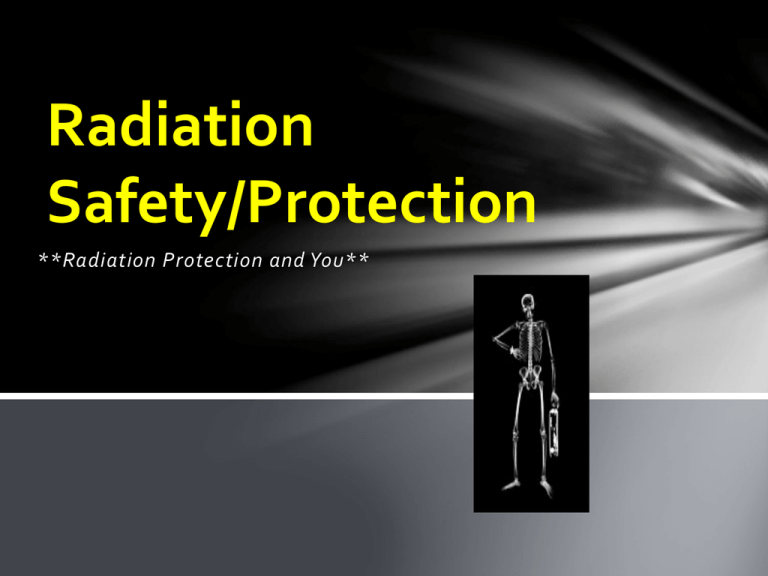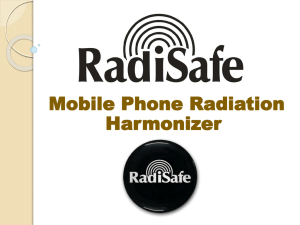Radiation Safety/Protection
advertisement

Radiation Safety/Protection **Radiation Protection and You** Radiation Safety/Protection Medical diagnostic x-rays contribute more to the exposure of the population than do all other man-made sources of radiation. As an occupational radiation worker, you may be exposed to more radiation that the general public. Because the risks of undesirable effects may be greater for young people, persons under 18 years of age. Permitted to be exposed to only 10 % of the adult occupational limits. This lower limit is also applied members of the general public. The amount of radiation a person receives is called a "dose" and is measured in “Rem” (R), “Milli-Rem” (mr). The average person in the United States gets a dose of 1.0 rem (1000 mr) from natural sources every twelve (12) years. The dose from natural radiation is higher in some states, such as Colorado, Wyoming, and South Dakota, primarily because of cosmic radiation. There the average person gets 1.0 rem (1000 mr) every eight (8) years. All absorbed x-radiation, no matter how small the dose, has biological effects. All medical radiography is considered harmful. These harmful consequences result from the ionizing effects of the radiation within the human body. The fact that it nevertheless continues to be used is due to the undoubted benefits it also brings. Radiation Safety/Protection Many people receive additional radiation for medical reasons. The annual radiation dose averaged over the entire United States population from diagnostic medical X-rays is 0.072 rem (72 mr) per year. The average dose from one chest X-Ray is only 0.045 rem (45 mr). Radiation, like many things, can be harmful. A large dose to the whole body (such as 600 rems [600,000 mr] in one day) would probably cause death in about thirty (30) days, but such large doses result only from rare accidents. Here at Medical Center Hospital the risk of receiving such a large dose is almost impossible. This in part due to the fact that the diagnostic and therapeutic levels of radioactivity and the electronic radiation producers are considered very low radiation emitters. The control of exposure to radiation is based on the assumption that any exposure, no matter how small, involves some risk. The occupational exposure limits are set so low, however, that medical evidence gathered over the past fifty (50) years indicates no clinically observable injuries to individuals due to radiation exposures when the established radiation limits are not exceeded. This was true even for exposures received under the early occupational exposure levels, which were many times higher than the present limits. Thus the risk to individual at the occupational exposure levels is considered to be very low. Radiation Safety/Protection But still so little is known about such things as the carcinogenic effects of radiation it is impossible to say that the risk is zero. Every care must continue to be taken to keep all irradiation to an absolute minimum. The current exposure limits for people working in the radiation environment have been developed and carefully reviewed by nationally and internationally recognized groups of scientists. All TRCR licensees are now required, (Title 10, Part 19 of the Code of Federal Regulations), to inform all individuals who work in a restricted area of the health protection problems associated with radiation exposure. The regulations also state, (Title 10, Part 20), that licensees should keep radiation exposure “as low as reasonably achievable”, ( ALARA). Occupational exposures to radiation are being kept very low. However the National Council on Radiation Protection, the Nuclear Regulatory Commission, and the Texas Department of Health/Bureau of Radiation Control have recommended that the radiation dose to a pregnant women should not exceed 0.5 rems (500 mr). Since this 0.5 rems (500 mr) is lower than the radiation dose generally permitted to adult workers, the declared pregnant women should take special actions to avoid receiving unnecessary radiation exposures. If you do become pregnant and your work assignment is in the radiation environment you should contact your immediate supervisor and declare your pregnancy status. If they are unavailable please contact the Radiation Physicist or the Quality Control Coordinator/Radiology Services at ext. 1299. DO SO WITHOUT DELAY !!! CONTROLLING YOUR RADIATION EXPOSURE The radiation protection programs, here at Medical Center Hospital, have two facets: -the continuous evaluation of exposure -the reduction of exposure by any applicable control. We have touched on the evaluation of exposure in the previous section, in this training section we will be concentrating on the methods/techniques that are available to you, the employee, for reducing your exposure in the radiation environment. There are three (3) cardinal rules for personal radiation protection. These radiation protection rules were developed in the early atomic pioneering years. These methods work and are the standard industry vanguards for radiation safety. The THREE methods of reducing radiation exposure 1. MINIMIZE TIME: The radiation dose to an individual is directly related to the duration of exposure. If the time during which an individual is exposed to radiation is doubled, then the radiation exposure will be doubled. Exposure time should be kept to the minimum consistent with sound economical operation. **RULE OF THUMB: Do not enter any area where ionizing radiation is present unless absolutely necessary. Listen for the technologist to announce “X-Ray”, “X-Ray” remove yourself from the area if possible. If not, utilize the protection of shielding and/or distance. The THREE methods of reducing radiation exposure 2. MAXIMIZE DISTANCE: As the distance between the source of radiation and an individual increases, the radiation exposure decreases rapidly. Radiation intensity decreases according to the Inverse Square Law. Doubling the distance drops the radiation exposure rate by 1/4, tripling the distance, 1/9 and so on. **RULE OF THUMB: This concept of radiation protection is the easiest method to use. At any time that ionizing radiation is present simply increase you distance from the source or X-Ray tube. Remember ever six (6) feet is equal to one (1) Half Value Layer. Reference "Maximize Shielding" below. ***Note***: How far is six (6) feet ? Each square of tile on the floor is roughly one (1) square foot. Count six square and you have approximately six (6) feet. This distance is equal to one Half Value Layer. The THREE methods of reducing radiation exposure 3. MAXIMIZE SHIELDING: By placing shielding material between the radiation point source (i.e.: X-Ray tube) and you. The principle follows that the denser a material, of a barrier, the greater is its ability to attenuate (absorb) the passage of radiation. Shielding used in Diagnostic Radiology usually consists of high density materials such as lead (Pb) or its equivalent. The protective barriers used, will provide a Half Value Layer from the radiation or better stated one Half Value Layer is the thickness of material that will reduce the radiation intensity to one half its original value. **RULE OF THUMB: The concept of shielding can be satisfied by using the lead protective aprons whenever ionizing radiation is present. Remember alternate protective shielding includes: a. Shielding incorporated into any equipment’s design. b. Mobile or temporary devices such as movable screens, lead aprons/gloves. c. Permanent protective barriers such as walls, doors, and concrete. d. Any other materials that can be placed between you and the point source of ionizing radiation. Ideally you will want to combine any combination of two (2) of the three (3) radiation protection rules listed above. 7 BASIC RADIATION PROTECTION PRINCIPLES 1. Understand and apply the cardinal principles of radiation protection: Time Distance - Shielding. 2. DO NOT allow familiarity to result in false security. 3. NEVER stand in path of the primary radiation beam. 4. ALWAYS wear protective aprons and gloves when not behind a protective barrier. 5. ALWAYS wear a personnel monitoring device (i.e.: film badge dosimeter or TLD ring dosimeter) and position it OUTSIDE the protective lead apron at collar level. 6. IF POSSIBLE NEVER hold a patient during radiographic examination. Use mechanical restraining devices whenever possible. Otherwise utilize staff on a rotating basis. NO OTHER HOSPITAL EMPLOYEES SHALL BE USED ROUTINELY TO HOLD PATIENTS. 7. The person holding the patient MUST ALWAYS wear a lead apron and, if possible, lead gloves and thyroid shield. This training session has been provided to help inform you of your role in Medical Center Hospital's "Radiation Safety Programs". As I'm sure you are all aware we have tried to lightly touch on only the critical areas of concern. Please be aware that there is a system currently in place to provide radiation safety information and guidance to this facilities patients and staff.






